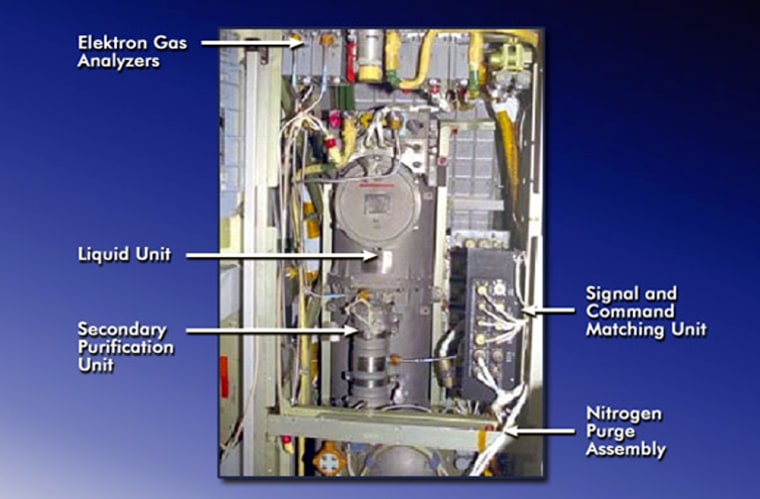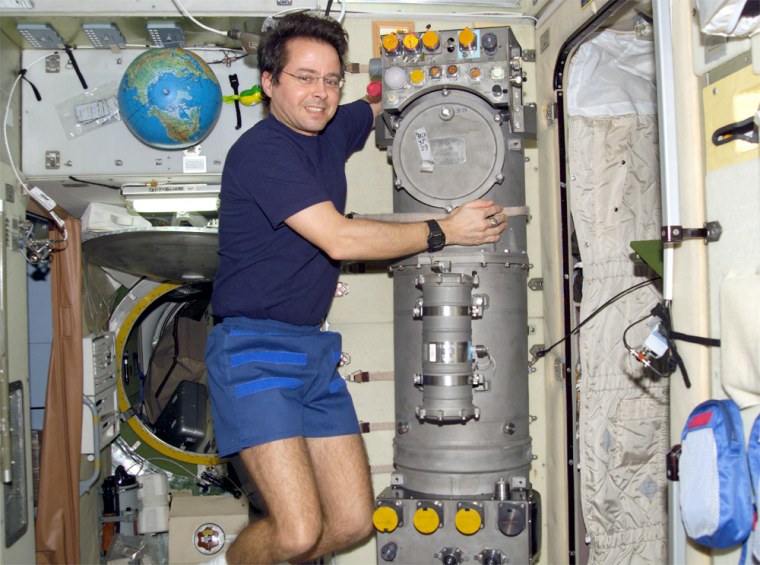Is the oxygen generator aboard the international space station working or not? Its status has been changing on an almost hourly basis, as the crew tries out new repair suggestions from Moscow and the balky unit invents new ways to break down. Although a NASA spokesman insisted that the total failure of the unit was “extremely unlikely,” engineers familiar with the generator's quirks believe it is nearing an irremediable breakdown.
But it’s not a crisis. Neither the crew’s safety nor the success of their current mission is threatened, since there are several backup sources of oxygen, and timely resupply from Earth is feasible. Of wider significance is the reliability of next-generation oxygen generators during future human missions beyond Earth orbit, when spare parts and backup supplies will be difficult or impossible to come by.
The space station is proving to be the perfect proving ground for this type of equipment, because the physical processes used cannot be simulated on Earth’s surface.
The current Russian-built Elektron system processes liquid water mixed with a fluid electrolyte, creating bubbles of oxygen for breathing as well as bubbles of waste hydrogen gas. All that gas has to be separated from the liquid before the chemical encrustations that form on their surface jam the unit’s small pumps.
But in the zero-gravity environment of outer space, gas bubbles don't rise within a liquid — so a process that is trivial for earthly high-school chemistry labs becomes devilishly difficult. Since its first tests aboard Russia's Mir space station, almost 20 years ago, the Elektron design has gone through about half a dozen models. Each model is less trouble-prone than the previous one, but persnickety all the same. Despite the best efforts at the time, each model has eventually broken down.
Never a dull moment in space
The crew had only just been relieved of a serious food shortage by the arrival of a robot supply ship on Christmas Day when the threat of an oxygen shortage returned. The Elektron unit had been operating smoothly for several months after a major overhaul in September, but three days after Chistmas it suddenly shut itself down.
“On December 28, 2004, the Elektron began failing due to excessive gas bubbles in the electrolyte circulation loop, which caused the internal circulation pumps to shut down,” according to an internal NASA status report obtained by MSNBC.com, “After each failure, the Elektron was successfully restarted until January 1, 2005, when it would not continue operating.”

For the next several days, Russian cosmonaut Salizhan Sharipov tried to remove the excess bubbles himself — first with a manual pump, then with an electrical pump. “The bubbles were reduced in size and frequency,” the NASA report noted, “but Elektron restarts were not successful.”
Suspecting that the fluid in the electrolyte/water mixture had grown too thin, Russian experts recommended a transfusion from an older unit that no longer worked for other reasons. On Thursday, after collecting the required hoses and clamps and positioning the old unit nearby, the crew performed the procedure.
The unit was then started up and ran for several hours, during which NASA and Russian news agencies released the news that the repair had been successful. But after about five hours, the Elektron shut itself down. This was just before bedtime, and the crew had time to restart the unit before retiring for the night.
Soon after they fell asleep, Elektron’s primary pump shut down and its backup pump kicked in. That unit lasted another six hours before the entire device shut itself off. Flight controllers in Moscow let the crew sleep.
When they awoke, they were told to restart the Elektron again, but to do so at almost twice the normal power level. This worked for a few hours, but when Sharipov had to turn on some exercise equipment, the amperage to the Elektron dropped — and it shut itself off again. Sharipov's American partner on the station, commander Leroy Chiao, ran a supplemental power cable from the U.S. side of the station, and with the power boost, the device came back on and stayed on.
NASA spokesman Rob Navias put a positive spin on his description of the repeated failures: “At normal amps it seems to be experiencing only an intermittent amount of success,” he explained. That was one way of saying it.
When (not if) Elektron dies
Although Navias referred to a permanent failure of the Elektron unit as “a highly unlikely event,” space engineers who have spoken with MSNBC.com are considerably less sanguine. They describe a typical pattern of increasingly frequent shutdowns followed by a final shutdown from which no restart, at any power level, is possible. Every other flown Elektron unit has died this way, and the current unit is the last one in stock.
There are several other sources of oxygen aboard the station, testifying to a multiple redundancy in critical systems.
First, the large internal volume of the station means that even without any oxygen generation at all, the air levels remain within normal sea-level range for a week or so. After that point, they begin to simulate the oxygen levels at higher elevations — Denver after another week, Tibet a week later, then thinner and thinner air. This affords plenty of time for making repairs or tapping other supplies.
About six weeks’ worth of oxygen-generating canisters are stored aboard the station, for exactly this kind of hardware problem. The technology is generally pretty reliable, although they're notorious for occasionally flaming out of control. Such a flare-up nearly killed the crew aboard the Mir space station in February 1997.
A looming problem is that one of the two firing chambers for these canisters is broken, and the second one hasn’t been used in a long time.
Each Progress supply ship carries a small tank of extra oxygen, enough to last a few weeks — and some of that reserve was tapped this week.
High-pressure gas tanks attached to the exterior of the Quest airlock also contain significant quantities of compressed oxygen. But this would be the last resource to be expended, because the gas tanks are very expensive to recharge. The weight of the high-pressure pumps in the space shuttle cargo bay far exceeds the weight of the gas to be reloaded into them.
In all, these emergency supplies amount to more than 150 days of oxygen for the two-man crew, enough to last into June, when a new crew will already have taken over. Two more robot supply flights are scheduled to occur in this period, and each of those flights could bring up still more oxygen.
Oxygen futures
So far, the only regenerative oxygen generation systems flown in space have been Russian ones. Reportedly, the Russians are completing a new design for a "solid electrolyte" electrolyzer, which would avoid the problems of bubbles in the fluid electrolyte. NASA sources say they expect this unit to be launched this year, but no further details are available.
Long-range plans for the station call for a permanent crew of six, with up to 12 or 13 people aboard during shuttle dockings. By then, a larger oxygen generator should be on the job. NASA has contracted with Hamilton Sundstrand to deliver a “solid polymer electrolyte” system aboard the Node-3 module, which is to be launched sometime in 2008.
According to the company's Web site, Hamilton Sundstrand has been designing, manufacturing and producing these kinds of electrochemical cells for more than 40 years.They have been qualified to very demanding standards for use on board U.S. and British nuclear submarines. They have racked up more than 40 million hours of system operation in more than a dozen different current service applications.
These systems use a rugged polymer membrane, similar to Teflon, that would eliminate the need for the liquid electrolyte that has proven so troublesome on the Russian units.
